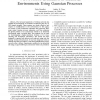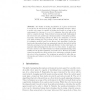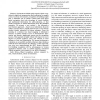88 search results - page 16 / 18 » An Autonomous Robotic System for Mapping Abandoned Mines |
IROS
2008
IEEE
14 years 1 months ago
2008
IEEE
—The increased popularity of wireless networks has enabled the development of localization techniques that rely on WiFi signal strength. These systems are cheap, effective, and r...
ICRA
2006
IEEE
14 years 1 months ago
2006
IEEE
— The dangerous and time sensitive nature of a disaster area makes it an ideal application for robotic exploration. Our long term goal is to enable humans, software agents, and a...
IBPRIA
2005
Springer
14 years 28 days ago
2005
Springer
The ability of finding its situation in a given environment is crucial for an autonomous agent. While navigating through a space, a mobile robot must be capable of finding its lo...
TROB
2002
13 years 7 months ago
2002
Abstract-We describe Localization-Space Trails (LOST), a method that enables a team of robots to navigate between places of interest in an initially unknown environment using a tra...
ICRA
2005
IEEE
14 years 1 months ago
2005
IEEE
Abstract— Autonomous mobile agents require object recognition for high level interpretation and localization in complex scenes. In urban environments, recognition of buildings mi...



